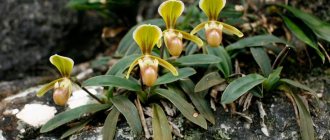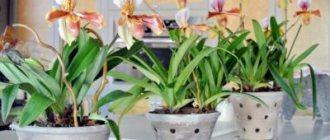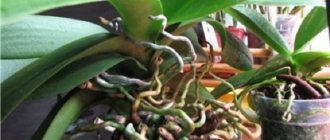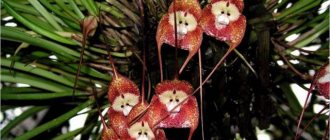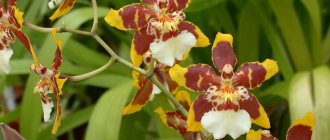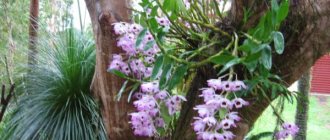What does the Miltonia orchid look like?
Miltonia is one of the many genera included in the Orchidaceae family. It received its name in honor of the British aristocrat, who was one of the first to collect these extraordinary plants - Adligen Milton. The first representative of the genus (Miltonia resplendent) was described in 1837 by the famous botanist John Lindley. The natural habitat of the plant is Brazil, Colombia, Venezuela, Central America.
Under natural conditions, Miltonia most often settle on tree trunks, using them as support.
For more than 60 years, all orchids found in the specified territory and resembling in appearance the one described by Lindley were called miltonia. But at the end of the 19th century they were divided into Miltonia proper and Miltoniopsis (literally translated - “Miltonia-like”), based on the identified differences in morphology. The first genus includes Brazilian lowland plants that live in tropical forests, the second includes Colombian orchids that prefer mountains. But there are still certain difficulties in classification.
Miltoniopsis is more difficult to grow than Miltonia. At home, they are accustomed to fairly low temperatures, which are difficult to recreate at home.
Like most other orchids, miltonia is an epiphyte. She uses tree trunks and branches as support. At the same time, the plant is not a parasite, receiving the necessary moisture and nutrients from the atmosphere with the help of a developed system of aerial roots. Somewhat less often, the orchid settles directly on the rocks, clinging to the smallest cracks in the stones.
Miltonias are herbaceous perennial evergreens. They differ from other orchids in the non-standard shade of the leaves - grayish or yellowish, although a green undertone is also present. The leaf length is 35–40 cm. They are rigid, lanceolate, sometimes slightly bent back.
Tuberidia or pseudobulbs (thickenings of the stem in which the plant stores water and nutrients) in Miltonia are small - 6–8 cm in length and 4–5 in width. Shape: elliptical or pear-shaped. They are flattened and arranged quite closely.
Miltonia's pseudobulbs, compared to other orchids, are quite small
Miltonia flowers captivate not with their exoticism, but, on the contrary, with their deliberate simplicity and bright colors. The most common colors are scarlet, lilac, pink, yellow, terracotta, snow-white and their various combinations. In shape they resemble the violas familiar to all Russians, which is why the plant also has a nickname - “pansies”.
Miltonia flowers in shape (and sometimes in the shade of the petals) resemble “pansies”, but the latter are noticeably smaller
One pseudobulb can produce several flower stalks with 6–8 buds on each. They are located in the axils of the leaves. The flowers are quite large - 10–12 cm in diameter. The edges of the petals are often corrugated.
The fewer buds on the peduncle, the larger each of them and the richer the very “delicious” honey aroma.
Miltonia blooms last from three to six weeks. But on cut flower stalks, the buds wither within 2–3 hours.
Video: appearance of miltonia
Reproduction
Reproduction of the Miltonia orchid occurs by pseudobulbs and division of the root system. It is best to divide the plant when replanting it. The rhizome is divided in spring, separating part of the tuber along with the shoot from the orchid. The shoot is planted in a mixture of peat, perlite and humus. Watering is carried out 7 days after transplantation.
The pseudobulb is part of the tuber; it is separated after flowering and planted in a narrow container with peat and sand. For escape, a greenhouse is created using a plastic bag, the bag is opened briefly every day, watering is carried out after 4 days, and after the pseudobulb has germinated, the bag is removed.
Varieties grown at home
Compared to other orchids, very few Miltonia species are currently known. The genus includes about two dozen “natural” orchids, 7–10 “natural” hybrids, including interspecific ones (such as Miltassia - the result of crossing Miltonia and Brassia), as well as about 40 breeding achievements. "True" miltonias are considered an endangered species. Therefore, mostly adapted plants from nurseries and selection hybrids go on sale. Most often in the homes of flower growers you can find the following types:
- Miltonia is brilliant or noticeable (spectabilis). It is distinguished by its endurance - it tolerates temperatures that are too high and too low for an orchid relatively painlessly. The pseudobulbs are noticeably flattened laterally, which is why they appear elongated. Lime colored leaves. The flowers are 6–8 cm in diameter. The petals are white, with a slight lilac or pinkish tint, covered with a pattern of bright crimson or purple veins. Peak flowering occurs in mid to late summer.
- Miltonia yellowish (flavescens). What is atypical for these orchids is that they “live” in Argentina. Each pseudobulb has two leaves. The peduncle bears 12–15 buds. The petals are narrow, straw-colored. The beginning of flowering can occur at any time from March to August.
- Miltonia white (candida). It is low maintenance. Flowering most often occurs in autumn. Each pseudobulb produces 1–2 peduncles with 4–6 buds. The shade of the petals varies from chocolate to yellowish-brown, the edges are corrugated. It is characterized by a pattern of small brick-colored specks. The species received its name due to its snow-white lip, which stands out effectively against the general background (a pink or crimson spot at its base is normal). Flower diameter is 8–10 cm.
- Miltonia Regnelli (regnellii), sometimes incorrectly called "Miltonia Regnell". It has very decorative leaves - thin, glossy. Each peduncle, about 0.5 m high, has 5–6 buds. The petals are snow-white, the lip is lilac, with a pattern of darker strokes. “Forgiving” to minor mistakes in care.
- Close's Miltonia (clowesi). Strongly resembles white miltonia. There are 7–10 buds in an inflorescence. The peduncle is quite tall - up to 45 cm. The petals are dull yellow with a pattern of dark brown strokes and stripes. The base of the lip is inky purple, then this color abruptly turns white. It is shaped like a guitar.
- Miltony Varshevich (wascewiezii). Unlike most miltonias, it blooms in winter or early spring. Inflorescences in the shape of a brush or broom. The petals are corrugated, brick-colored, with a yellowish or creamy tip. The lip is quite wide, deep purple, with a white border.
- Miltonia hybrid (hybrida). Each pseudobulb, 7–10 cm long, has two leaves (20–30 cm). The inflorescence is in the shape of a loose brush, bearing 3–5 buds. The petals are colored in different shades of red and pink. They are velvety to the touch. The flowers are almost flat, the lip is wide, oval. They resemble violets, but are much larger (7–8 cm in diameter).
- Miltonia moth is a hybrid. Currently, most botanists, taking into account the single-leaf pseudobulbs and the specific structure of the flower, classify it as miltoniopsis. The plant requires fairly cool indoor temperatures and a long dormant period. The flowers are about 5 cm in diameter, the petals are snow-white, with a pattern of yellow or scarlet strokes. The start of flowering extends from July to October.
- Miltonia Hudson Bay. Selective hybrid. The petals are white-purple, with a dark purple base. Covered with patterns of reddish stripes.
- Miltonia Red Tide. Large bright scarlet flowers, streaked with thin snow-white strokes.
- Miltonia Saint Heller. The petals are white and pink, with a bright crimson base.
Photo gallery: miltonias for home purchase
Miltonia resplendent is most often found on the window sills of flower growers.
Miltonia yellowish has petals of a very unusual straw color.
Miltonia snow-white owes its name to the lip of the corresponding shade.
Miltonia Renelia is able to “forgive” the grower for individual mistakes
Close's Miltonia differs from snow-white in having a more pronounced pattern on the petals
Miltonia Varshevich blooms in winter or early spring
The shade of Miltonia hybrid petals varies from soft pink to dark scarlet. Currently, most botanists classify Miltonia moth as a miltoniopsis.
Miltonia Hudson Bay is one of the most popular breeding hybrids Miltonia Red Tide is valued for its very large bright flowers
Miltonia Saint Heller - nothing special, just very delicate flowers
How to create an optimal microclimate for a plant?
Miltonia is relatively unpretentious, but the microclimate of its historical homeland is very different from that created in modern apartments. Meanwhile, optimal conditions are the key to regular flowering. Therefore, before you get an orchid, you need to familiarize yourself with its “requirements” and, if possible, create a comfortable environment for it.
Table: optimal conditions for growing miltonia
| Factor | Recommendations |
| Location | The sill of a window facing east or west. The plant cannot tolerate stagnant air, so the room must be ventilated daily, while protecting the orchid from cold drafts. |
| Lighting | Prefers bright diffused light, but will tolerate light partial shade. In extreme heat it is even desirable. The plant must be shaded from direct sunlight so that it does not get burned. If the lighting suits miltonia, the leaves acquire a beautiful pinkish tint. In winter and in cloudy weather, it is necessary to use special phytolamps, extending the daylight hours to 12–15 hours. |
| Temperature | 20–23ºС in spring and summer during the day and 3–4ºС lower in autumn and winter, as well as at night during the active growing season. Miltonia reacts very negatively to sharp fluctuations. 12ºС and below - and the plant will die. |
| Air humidity | The optimal indicator is about 70% (in an apartment, as a rule, it does not exceed 50%). The higher the room temperature, the higher the humidity should be. The air surrounding miltonia is sprayed daily, wet pebbles or expanded clay are placed in the tray of the pot, and the roots are covered with wet sphagnum moss. You can also place a wide container of water or a special humidifier nearby. |
Miltonia loves bright light, but does not tolerate direct sunlight
Active growth and rest period
It blooms from early summer to mid-autumn, and under ideal conditions can do so several times a year or even year-round. Some time after flowering, it goes into hibernation until the beginning of spring, when it begins its growth period.
It blooms profusely and has many flower stalks. The flowers smell like a sweet rose with a hint of citrus. An adult lush plant can scent the entire room.
Planting and replanting miltonia: from soil selection to the very depths
Miltonia, like other orchids, is not very popular with replanting. Therefore, it is carried out once every 3-4 years in emergency situations: roots protrude from the drainage holes (aerial roots protruding from the top of the pot are normal); the soil literally decayed, turning into dust; the substrate is covered with moss or whitish coating; the orchid roots have rotted and so on. The best time for the procedure is spring. The orchid should “wake up” (new shoots have reached a length of approximately 5 cm).
Miltonia does not need a large deep pot - its root system is superficial, the roots are quite fragile. Of the materials, you should give preference to plastic - it retains moisture better. A transparent container will give you the opportunity to monitor the condition of the roots and notice in time the beginning development of rot. In addition, miltonia roots contain chlorophyll, therefore, they participate in photosynthesis - such a container will give them this opportunity. The diameter of the pot is increased by 3–5 cm compared to the previous one.
The substrate for miltonia bears little resemblance to the soil suitable for other indoor plants. There is a special soil in stores, consisting mainly of small pieces of bark, chopped dry sphagnum moss, peat chips and charcoal (all ingredients are taken in approximately equal proportions). But you can mix it yourself, after pre-treating all the ingredients with steam for disinfection:
- fertile turf, leaf soil, chopped sphagnum moss or coconut fiber, chopped fern rhizomes (about equal parts);
- finely chopped pine bark and loose peat, preferably high red peat (1:1);
- pine or spruce bark, perlite or vermiculite, sphagnum moss (2:1:1).
- conifer bark, fern rhizomes, peat chips, polystyrene foam (6:4:2:1).
Sometimes crushed chalk, activated carbon, and crumbs from old red bricks (10–15% of the volume of the mixture) are added to the finished substrate. This prevents the development of rot.
The substrate for orchids bears little resemblance to soil in the usual sense of the word.
The transplant itself looks like this:
- Place the pot of miltonia in a bowl of water for 1.5–2 hours.
- Remove the plant from the container, clean the roots from the substrate.
- Carefully inspect the root system. Using a sharp, clean knife, cut off all dead and rotted areas down to healthy tissue.
- Treat the “wounds” by sprinkling them with crushed chalk, colloidal sulfur, activated carbon, and cinnamon. If you don’t have anything at hand, lubricate it with brilliant green or iodine.
- Allow the orchid to air dry for 2-8 hours. The larger the plant, the more time it requires.
- Fill the new pot one third full with expanded clay or other drainage material. On top - 2–3 cm of substrate.
- Place the orchid in the center of the container, add soil around the edges. Make sure it only covers the roots. Pseudobulbs remain completely on the surface.
- Place the plant in light partial shade for 2–3 days. Don't water. After this time, moderately moisten the substrate and return the pot to its original place.
Take your time to replant miltonia you just purchased at the store. Give the plant 7-10 days to acclimate. During this time, decide on a place for it. Orchids do not like "moving".
When replanting an orchid, the roots must be cleared of old substrate.
Video: how to transplant miltonia correctly
Choosing a substrate for an orchid
The substrate sold in stores is not entirely suitable, so it makes sense to tackle the issue yourself - buy or collect pine bark in the forest, peel and boil it, add charcoal, peat, sphagnum moss, which is added to the mixture in small quantities and placed in the upper part soil. It is strongly recommended to replace moss every three months.
Proper care of an orchid
Flower growers value miltonia not least for its relative undemanding nature and some “lenience” to the owner’s unintentional mistakes. However, if you do not follow the recommendations for caring for it, the plant will die quite quickly. Watering is especially important. Orchids do not tolerate either waterlogged or overdried substrates.
Watering
The plant needs abundant watering from the moment new shoots form until the end of flowering. Water is poured along the edges of the pot, preventing it from getting on the pseudobulbs. It is best to use a watering can with a long spout. Another option is the immersion method. The pot is immersed in a basin of water heated to 30–35ºC for 1.5–2 hours, then the excess moisture is allowed to drain.
The best way to water an orchid is by immersion.
You can also water a non-blooming orchid from the shower for 10–15 minutes, simulating tropical rain. At the end of the procedure, the leaves must be wiped dry with a soft cloth.
The substrate should always be slightly damp. In dry soil, the orchid sheds buds; in wet soil, the pseudobulbs rot. Usually one watering every 5-7 days is sufficient. Naturally, in hot weather this interval decreases.
Only soft water (ideally rain or melt water) is used for irrigation and spraying. If this is not possible, the tap water is left to settle, passed through a filter or boiled.
Fertilizer application
During the active growing season, miltonia is fed once every 12–15 days, using exclusively special fertilizers for orchids. Other drugs will do more harm than good. It is best to alternate root feeding and leaf spraying. In the latter case, the concentration of the drug is reduced by half compared to that recommended by the manufacturer.
Miltonia, like other orchids, is fed only with preparations specially designed for them.
Video: important nuances of plant care
Bloom
Miltonia does not have a specific flowering period. If the microclimate and care suit her, she can bloom almost all year round, with the exception of the dormant period. Fallen buds are immediately removed from the pot so as not to provoke the development of rot.
For the same purpose, the peduncle is also cut off, as close to the surface of the substrate as possible. There is no need to wait until it is completely dry. It is not advisable to use scissors - they seriously injure the stems. Secateurs or a regular kitchen knife are more suitable.
The flowering of miltonia is a real feast for the gardener's eyes; unfortunately, cut flowers wither within a few hours
Rest period
Miltonia’s “rest” begins when the plant has finished flowering and the new pseudobulbs are almost equal in size to last year’s. It lasts approximately two months. During this time, watering is reduced to once every 10–15 days, and fertilizing is stopped completely. The pot is transferred to a cool, bright place.
If there is no suitable room in which a constant temperature is maintained just below 20ºC, move the orchid as close to the window glass as possible and separate it from the warm room with a screen. Cover the heating radiators located nearby with a thick cloth.
When does an orchid need a transplant and how to do it
Miltonia transplantation is performed in several cases:
- as the aerial roots grow, it needs a larger pot;
- Root rotting or drying out has been detected;
- there is a slowdown in growth;
- the substrate is spoiled - salted, crushed, with a smell of mold or rot.
Most often, transplantation is carried out at the end of winter or spring, annually or once every 2 years. During this time, the soil loses its beneficial properties, and the roots grow. The optimal time for replanting is the beginning of the next stage of the growing season or after flowering. Work should not be carried out when fresh shoots more than 5 cm long have appeared and the process of growing their own roots has begun.
The soil is taken special for orchids. When purchasing in a store, you should pay attention that it consists of natural ingredients and not synthetic ones. Artificial fillers have the ability to accumulate salts, decompose over time, and release toxins, which negatively affects the growth and flowering of plants.
The bark and cones of coniferous trees are good substrate contents for the Miltonia orchid. You can add to it:
- charcoal;
- perlite;
- peat;
- walnut shell.
The soil is prepared taking into account the microclimate in the house. Charcoal is added to it at high humidity. Coconut flakes or fern roots will be needed in dry environments.
Miltonia transplant
Some useful recommendations for carrying out the work:
- One day before transplantation and several days later, the plant is not watered.
- In a dry room you can lightly spray.
- It is better to take a plastic pot with holes in the bottom. It shouldn't be too big. Transparency is not a requirement for him.
- The orchid is removed from the pot. Soak in water for 20-30 minutes. The roots are carefully examined and dry and rotten ones are removed. Treated with fungicides (for example, phytosporin).
- The bottom of the prepared container is covered with large pieces of pine bark, polystyrene foam, and sprinkled with part of the soil mixture.
- Place Miltonia in a new pot and fill the empty spaces with substrate. Compact it by tapping the walls of the pot. Don't press down.
Advice. Do not bury pseudobulbs into the ground. When planting in a pot, it is better to place the orchid not in the center, but closer to the edge, in order to leave room for growing new pseudobulbs.
Resuscitation of miltonia without roots
Miltonia, like any other orchid that is not watered correctly, often loses some or all of its roots. Do not rush to throw away the damaged plant; it can still be revived.
Do not rush to throw away miltonia that has lost its roots; the plant can be saved
- Remove the orchid from the pot, cut off all the rotten roots, leaving only the rosette.
- Immerse it for 10–15 minutes in a 2% solution of any fungicide (Bordeaux mixture, HOM, Cuprozan).
- Sprinkle the “wounds” with crushed chalk, colloidal sulfur, and cinnamon. Leave the orchid outdoors for 3-5 hours.
- Pour expanded clay into a small container (a layer 1–2 cm thick), and lay sterilized sphagnum moss on top.
- Moisten it with a weak solution of a root formation stimulator - Epin, Heteroauxin, Zircon (2-3 ml per liter of water). Place the socket.
- Place the container in a mini-greenhouse. Provide a constant temperature of 23–28ºС, air humidity at 70–100%, daylight hours of 12–15 hours.
- Until the roots grow to 3–5 cm (in 10–15 days), do not open the greenhouse. Then begin to gradually accustom the plant to new conditions. After 2–3 weeks, it can be transplanted into soil familiar to orchids.
A mini-greenhouse will help revive an orchid that has lost all or most of its roots
If there is no mini-greenhouse, proceed as follows:
- Treat the socket as described above.
- Every morning for 6 hours, place it in a deep container filled with water, heated to 35–40ºC, boiled or filtered. Only the very base should touch it, but not the leaves. To speed up the process, you can add 10 ml of liquid honey or sugar syrup to the vessel.
- After the specified time has passed, remove the socket and dry it in the open air until the next procedure.
- Wait until the roots grow to 3-5 cm, plant the orchid in the ground.
Resuscitation of an orchid in water will go faster if you add a little honey or sugar syrup to it
Video: how to save an orchid that has lost its roots
Growing
To avoid drying out and waterlogging the roots of Miltoniopsis, you need well-drained soil that does not dry out quickly. For example, 10% charcoal can be added to the bark of spruce and mahogany. A mixture of conifer bark (fine fraction) and perlite (10–20%) gives good results. For adult plants, it is recommended to take the bark of the middle fraction.
Miltoniopsis must be replanted annually, preferably in the cold season. At the same time, using a larger container is not as significant as replacing the soil. Autumn replanting allows the plant to fully recover by spring. In fresh soil the roots will develop well.
IN THE PHOTO: Special attention should be paid to choosing a pot. These orchids develop best in 10–13 cm containers. In pots of this volume, the risk of soil waterlogging is reduced.
When propagating by division, it is necessary to provide each new plant with 3 to 5 pseudobulbs. The larger the orchid, the easier it recovers after the procedure; the divisions acquire good immunity and begin flowering earlier.
Typical problems of a beginning gardener
A reliable “indicator” of the condition of miltonia is flowering. If flower stalks do not appear, the buds fall off, the plant is clearly not happy with something in its care. But there are other alarming symptoms that the grower should pay attention to and immediately begin to take action.
Table: how miltonia reacts to errors in care: leaves turn yellow and dry and not only
| What does the plant look like? | What is the reason? |
| The buds fall off without opening. | The room is too hot and/or the air humidity is not high enough. Another possible reason is cold drafts. |
| Short flowering. | Fertilizer deficiency or too short dormancy period. Either the room is too hot, the orchid is in direct sunlight without shading. |
| Pseudobulbs and leaf bases become covered with “wet” black spots. | Too frequent and/or too much watering. The situation is aggravated by low room temperatures and cold drafts. |
| The leaves turn yellow and fall off. | Nutrient deficiency. Or the wrong fertilizer has been selected. |
| The leaves are darkening. | Lack of light. |
| The leaves wrinkle, wither, and lose their tone. | Incorrect watering (both too much and too little). Or the orchid grows in a narrow pot, which does not allow its roots to develop properly. |
| Small black spots on the leaves. | Stagnant water in the pot (due to too heavy clay soil or lack of drainage holes). |
| Vague light (to almost complete transparency) spots on the leaves. | A burn caused by prolonged exposure to direct sunlight. |
| The tips of the leaves dry out. | Watering with hard water (this causes soil salinity). |
Sometimes an orchid sheds leaves or buds due to its proximity to ripe fruits. They emit ethylene, which is very harmful to flowers. “Champions” in this sense are bananas, pears and apples.
Dry miltonia leaves indicate that you are watering the plant too rarely.
Recommendations for fertilizing
Fertilize the Miltonia orchid using the dipping method. Once every 2-4 weeks, add fertilizer for orchids to the water when watering. Another method of fertilizing is spraying. The best method is alternating root and foliar feeding.
Experienced gardeners recommend reducing the amount indicated on the label by half.
The frequency of fertilizing depends on the ambient temperature - in a cool room they are carried out less often. If the orchid is in a dormant period, then it is not fertilized.
The period from April to September is the time of its growth, bud formation and flowering. At this time it needs fertilizer.
Common diseases and pests
The most dangerous for miltonia are various rots caused by waterlogging of the substrate. It also often becomes the object of close attention from insects that feed on plant sap. To minimize the risk of infection, special attention should be paid to preventive measures:
- quarantine for newly acquired plants (at least a month);
- placing indoor flowers and bouquets as far from each other as possible;
- weekly inspection and immediate isolation of the flower when the first suspicious symptoms appear;
- regular ventilation of the room and increasing air humidity by all available means;
- weekly irradiation of plants with a quartz lamp for 2–3 minutes;
- careful adherence to all care recommendations, especially with regard to watering and fertilizing;
- using only sterilized substrate, disinfected pots and tools.
Table: diseases and pests that often affect miltonia
| Disease or pest | Symptoms | Treatment |
| Root rot | Black-brown spots on leaves and pseudobulbs, mold on aerial roots, unpleasant putrid odor. |
Treatment will give results only at an early stage of the disease. An orchid that is severely damaged by rot can only be thrown away. |
| Brown rot | Light brown translucent spots on leaves and pseudobulbs. |
|
| Anthracnose | Small round “pressed in” spots of dark brown or black color on leaves and pseudobulbs. Over time, they become covered with a pinkish or yellowish coating. |
|
| Spider mite | Leaves and buds entangled in a thin web, blurry yellowish-beige spots on the underside of the leaf. |
|
| Thrips | Thin silver-beige strokes on the underside of the leaf, similar to scratches, small black “sticks” on the leaves and pseudobulbs. |
|
| Whitefly | Whitish butterflies, similar to small moths, fluttering from a flower at the slightest touch to it. |
|
| Shchitovka | Gray-brown rounded tubercles on leaves and pseudobulbs. Gradually they increase in volume, the surrounding tissues turn yellow or red. |
|
Photo gallery: diseases and pests that you will have to fight when growing miltonia
At the later stages of development of root rot, it is no longer possible to save the plant; it can only be thrown away
Brown rot may cause the orchid to lose most of its leaves and pseudobulbs.
Anthracnose is a fungal disease, so any copper-containing preparations - fungicides - are effective against it.
Spider mites are not insects, so special preparations are used to combat them - acaricides
Thrips suck out the juice of the plant, air gets into the resulting cavities, this explains the unnatural “pattern” on the leaves
Whiteflies are flying insects, so fly tape is effective against adults.
The scale insect is protected by a strong shell, so folk remedies will not help against it.
Diseases and parasites of Miltonia
An attack by spider mites, whiteflies, thrips, mealybugs and scale insects can be dangerous for an orchid. They all suck out the juices of the plant . At the first signs, Miltonia is quarantined and treated with insecticides.
Among the diseases that are harmful to the orchid are bacterial spots, anthracnose and rot that occur due to care errors. Affected areas of the plant should be removed, sections should be treated with charcoal , the substrate should be changed and care regimes should be adjusted. Sometimes fungicide treatment is necessary.
This video shows one of the orchid diseases and tells what to do in this case.



